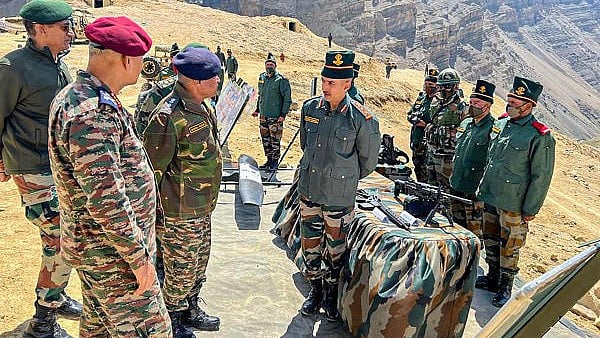
Indian Army personnel at the Line of Actual Control (LAC) Central Sector.
Credit: PTI Photo
New Delhi: The Indian Army intends to start patrolling Depsang and Demchok areas near the Line of Actual Control – the disputed boundary between Indian and China - by the month end as the disengagement process is likely to be over by October 29, sources said here on Friday.
Following an agreement reached after weeks of negotiations, the Indian and Chinese armies have finally started an exercise to disengage from the last two friction points and are expected to finish the task early next week.
“This means relocating to locations where the army was before April 2020. Troops, weapons, equipment and temporary accommodation like tents or huts will be relocated. The army will go back to the April 2020 status quo,” sources noted.
After four years of simmering tension at the LAC including violent clashes, officials from both sides announced earlier this week that a pact was reached to resolve the impasse at the last two flashpoints in eastern Ladakh.
Sources said New Delhi and Beijing signed two agreements – the first one at the diplomatic level, followed by a second one between the two armies specifying the details of the disengagement process.
The patrolling would commence by October end, officials said, refusing to divulge the frequency of such patrols.
Because of the harsh nature of the terrain, the troops will use vehicles and also walk up to the patrolling points that they used to go to. India will continue to use the UAVs and other assets for the surveillance of the LAC.
The local commanders will inform each other before dispatching the teams to avoid any miscommunication and minimise the chances of any clash or escalation of confrontation between the border guarding troops.
Since the LAC flare-up, China’s People’s Liberation Army troops blocked Indian soldiers' access to five patrolling points in Depsang – PP 10, 11, 11A, 12 and 13 – that are close to the LAC.
The area including Dault Beg Oldie airbase is a part of what is known as Sub Sector North in the India military parlance. It is a strategically important area not only because of its proximity to Siachen glacier and the Karakoram range, but also due to the flat nature of the terrain.
Sources maintained the breakthrough agreements were limited to Depsang and Demchok, where access to two patrolling points were blocked.
The contentious areas in Demchok also include traditional grazing lands across the Indus river and Charding Nullah. The agreements with China would now allow the grazing rights to the locals too.
Sources said the four buffer zones established at other friction points including Galwan and banks of Pangong Tso were not part of this agreement. The existing arrangements will continue at the buffer zones.
Once mutual trust is restored, the diplomats and commanders may discuss the way forward in the buffer zones that are mostly on the Indian side of the LAC.
The ties between the two neighbours nosedived following a fierce clash in the Galwan Valley in June 2020 that marked the most serious military conflict between the two sides since 1962.
Foreign Secretary Vikram Misri on October 21 announced finalisation of the breakthrough agreement.
Two days later, Prime Minister Narendra Modi and China President Xi Jinping endorsed the agreement on patrolling and disengagement along the LAC in eastern Ladakh during their bilateral meeting on the sidelines of the BRICS Summit in Kazan in Russia.
